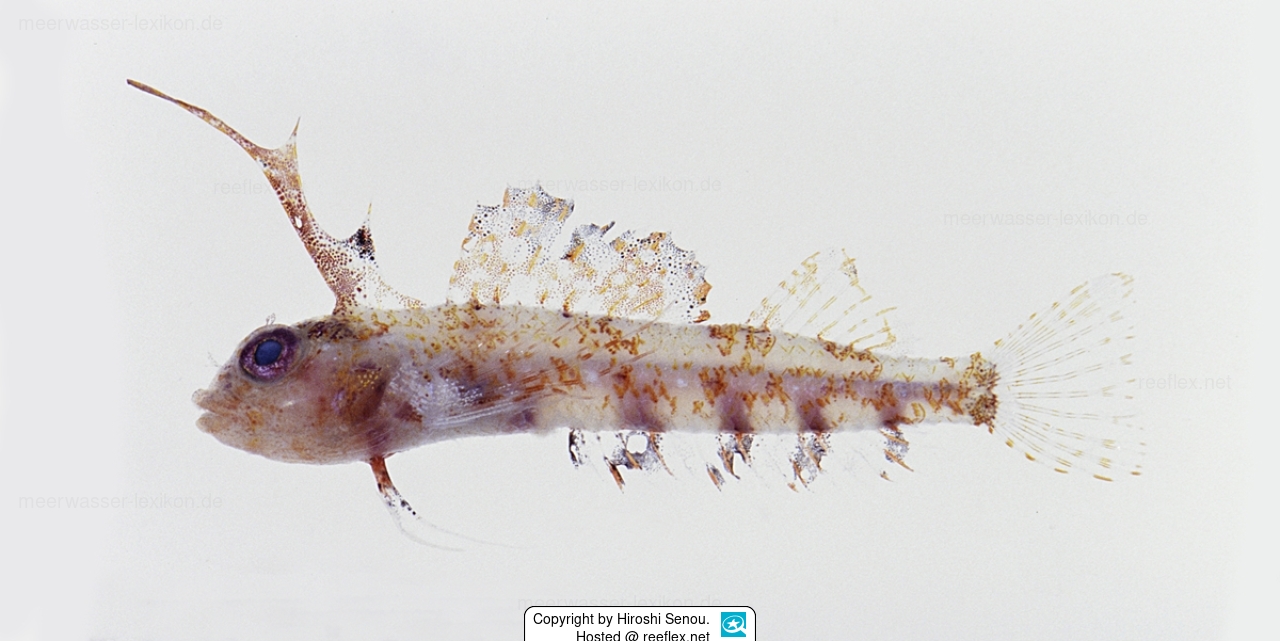Info
Enneapterygius velatus sp. nov (2018)
A new deepwater species, Enneapterygius velatus sp. nov. (Perciformes: Tripterygiidae), is described from two male specimens from Ryukyu Island, southern Japan, the holotype having been collected at a depth of 55 m and an underwater photograph taken between 30 and 41 m depth. The new species is characterized by an extremely long first dorsal-fin spine (length 31.6–34.0 % of SL), the first dorsal-fin spine bases close together, first dorsal-fin base length less than half the distance between the base of the third spine of the first dorsal-fin and origin of second dorsal-fin, first dorsal-fin spine base with developed inclinator muscles, long pelvic fins (tip of second ray extending beyond anal-fin origin), large body scales (8 circumpeduncular scales), the supratemporal sensory canals deeply U-shaped in dorsal view, snout profile weakly rounded, abdomen from between pelvic-fin bases to anal-fin origin covered by cycloid scales, body lacking significant blackish blotches and caudal-fin base with scattered melanophores in preserved specimens.
Classification:
Biota > Animalia (Kingdom) > Chordata (Phylum) > Vertebrata (Subphylum) > Gnathostomata (Superclass) > Pisces (Superclass) > Actinopteri (Class) > Perciformes (Order) > Blennioidei (Suborder) > Tripterygiidae (Family) > Tripterygiinae (Subfamily) > Enneapterygius (Genus)
Jumping guard
A jumping guard prevents (nocturnal) fish from jumping out.
Wrasses, blennies, hawkfishs and gobies jump out of an unprotected tank in fright if their night rest is disturbed, unfortunately these jumpers are found dried up in the morning on carpets, glass edges or later behind the tank.
https://www.korallenriff.de/en/article/1925_5_Jump_Protection_Solutions_for_Fish_in_the_Aquarium__5_Net_Covers.html
A small night light also helps, as it provides the fish with a means of orientation in the dark!
A new deepwater species, Enneapterygius velatus sp. nov. (Perciformes: Tripterygiidae), is described from two male specimens from Ryukyu Island, southern Japan, the holotype having been collected at a depth of 55 m and an underwater photograph taken between 30 and 41 m depth. The new species is characterized by an extremely long first dorsal-fin spine (length 31.6–34.0 % of SL), the first dorsal-fin spine bases close together, first dorsal-fin base length less than half the distance between the base of the third spine of the first dorsal-fin and origin of second dorsal-fin, first dorsal-fin spine base with developed inclinator muscles, long pelvic fins (tip of second ray extending beyond anal-fin origin), large body scales (8 circumpeduncular scales), the supratemporal sensory canals deeply U-shaped in dorsal view, snout profile weakly rounded, abdomen from between pelvic-fin bases to anal-fin origin covered by cycloid scales, body lacking significant blackish blotches and caudal-fin base with scattered melanophores in preserved specimens.
Classification:
Biota > Animalia (Kingdom) > Chordata (Phylum) > Vertebrata (Subphylum) > Gnathostomata (Superclass) > Pisces (Superclass) > Actinopteri (Class) > Perciformes (Order) > Blennioidei (Suborder) > Tripterygiidae (Family) > Tripterygiinae (Subfamily) > Enneapterygius (Genus)
Jumping guard
A jumping guard prevents (nocturnal) fish from jumping out.
Wrasses, blennies, hawkfishs and gobies jump out of an unprotected tank in fright if their night rest is disturbed, unfortunately these jumpers are found dried up in the morning on carpets, glass edges or later behind the tank.
https://www.korallenriff.de/en/article/1925_5_Jump_Protection_Solutions_for_Fish_in_the_Aquarium__5_Net_Covers.html
A small night light also helps, as it provides the fish with a means of orientation in the dark!







 Dr. Hiroshi Senou, Japan
Dr. Hiroshi Senou, Japan




































